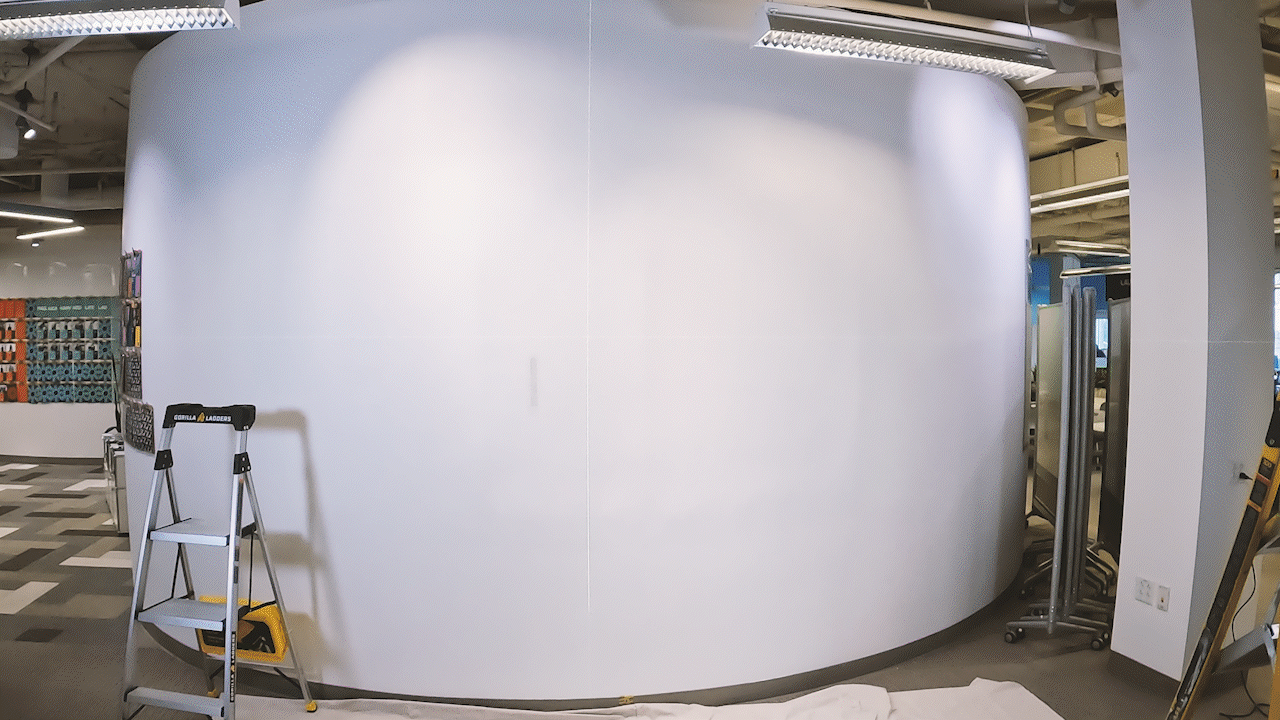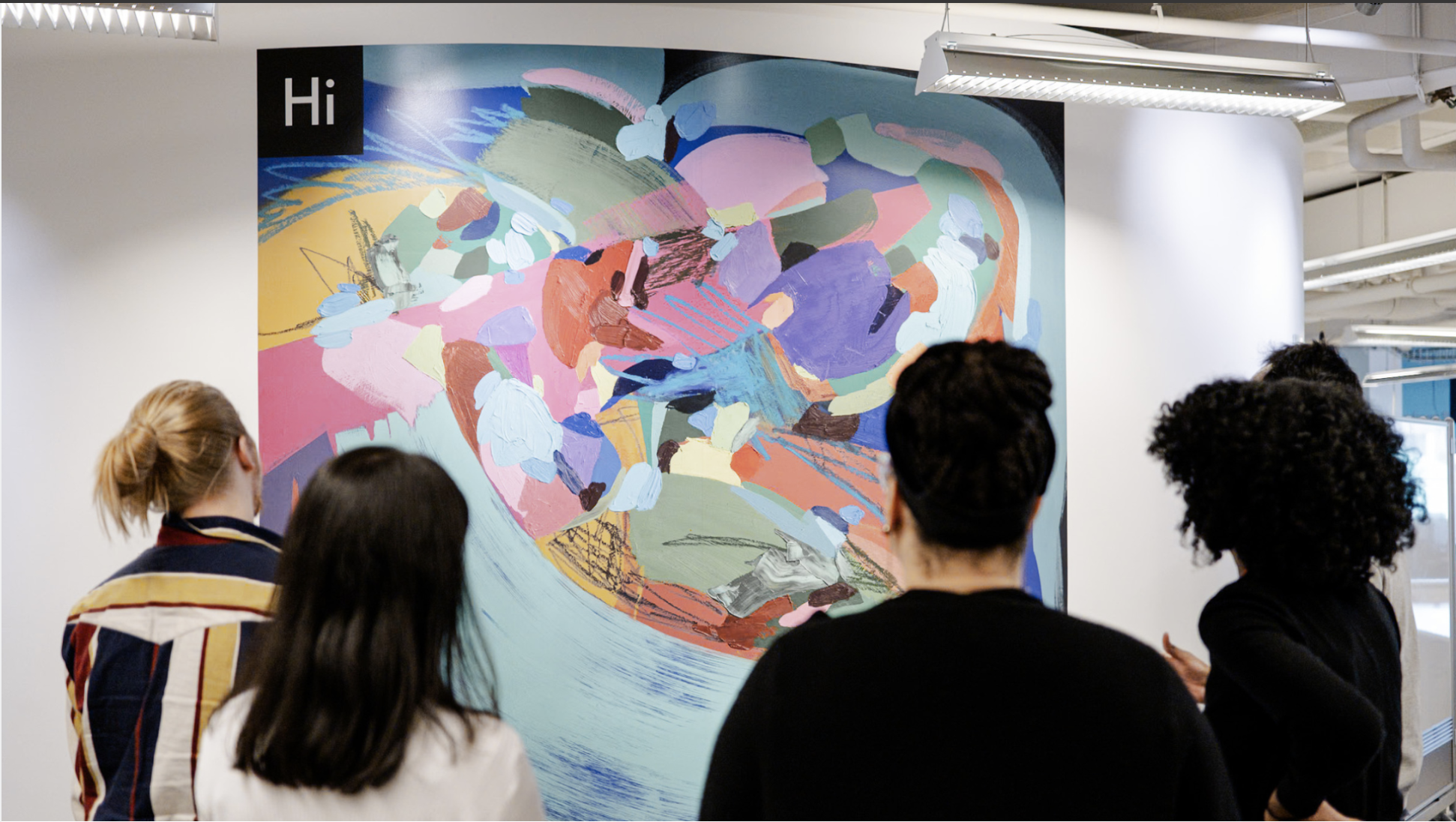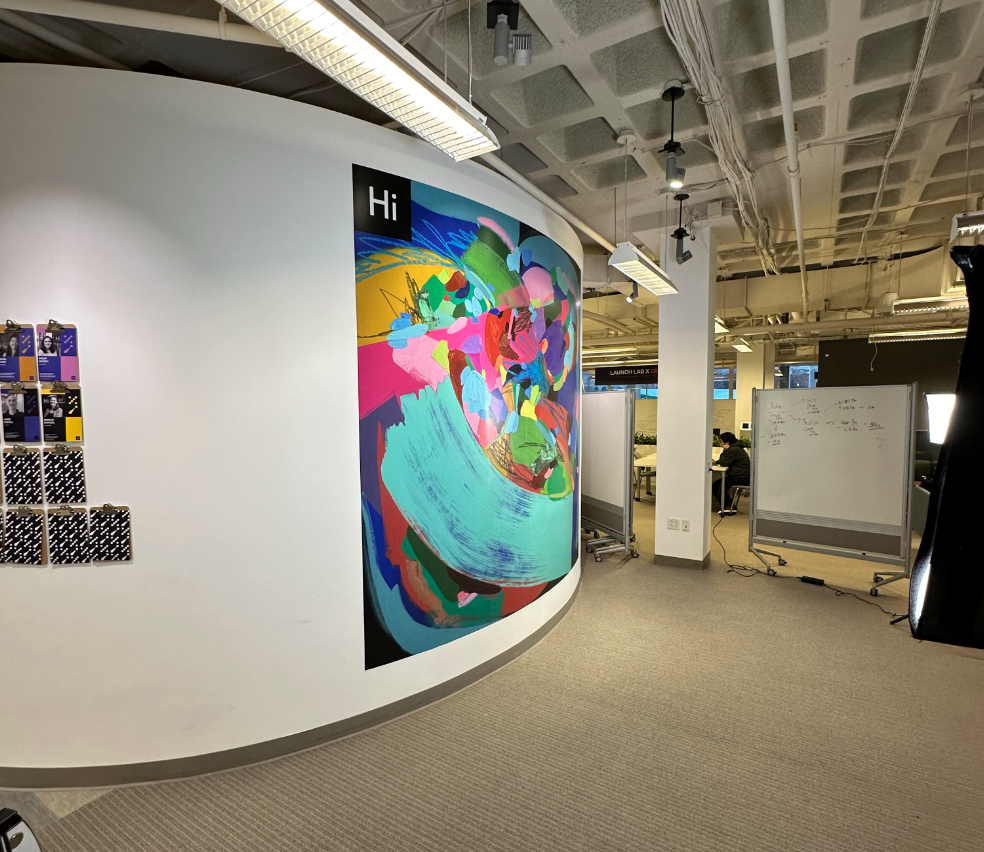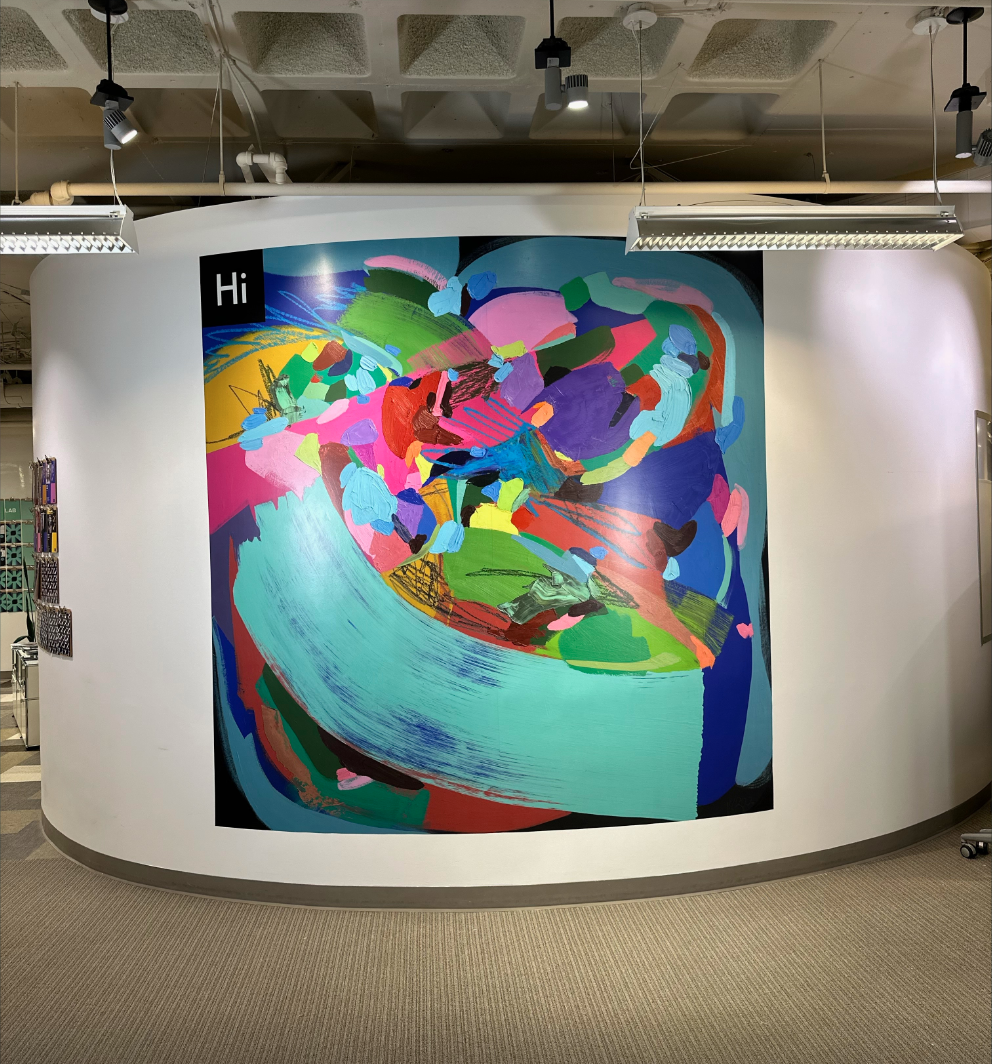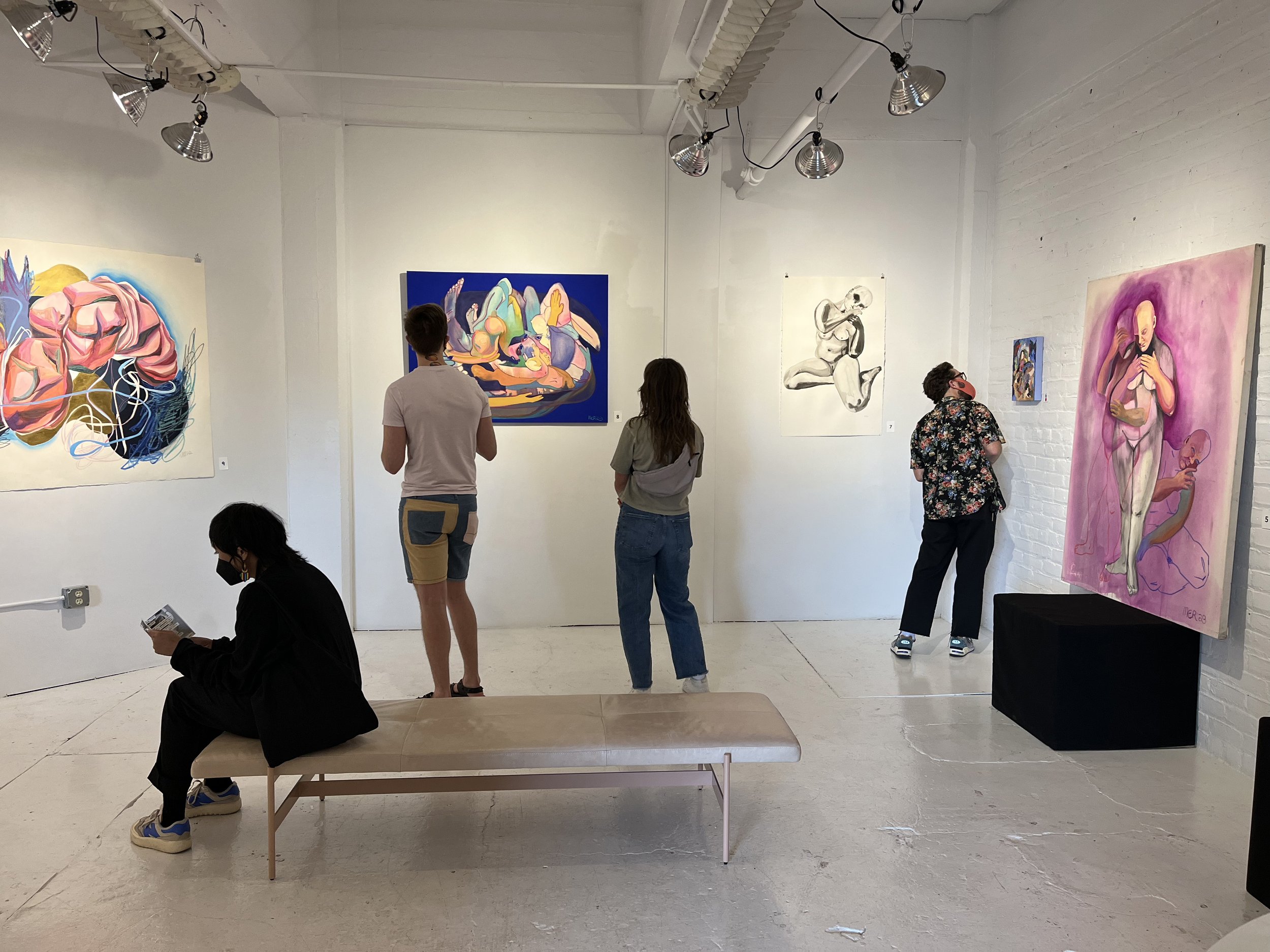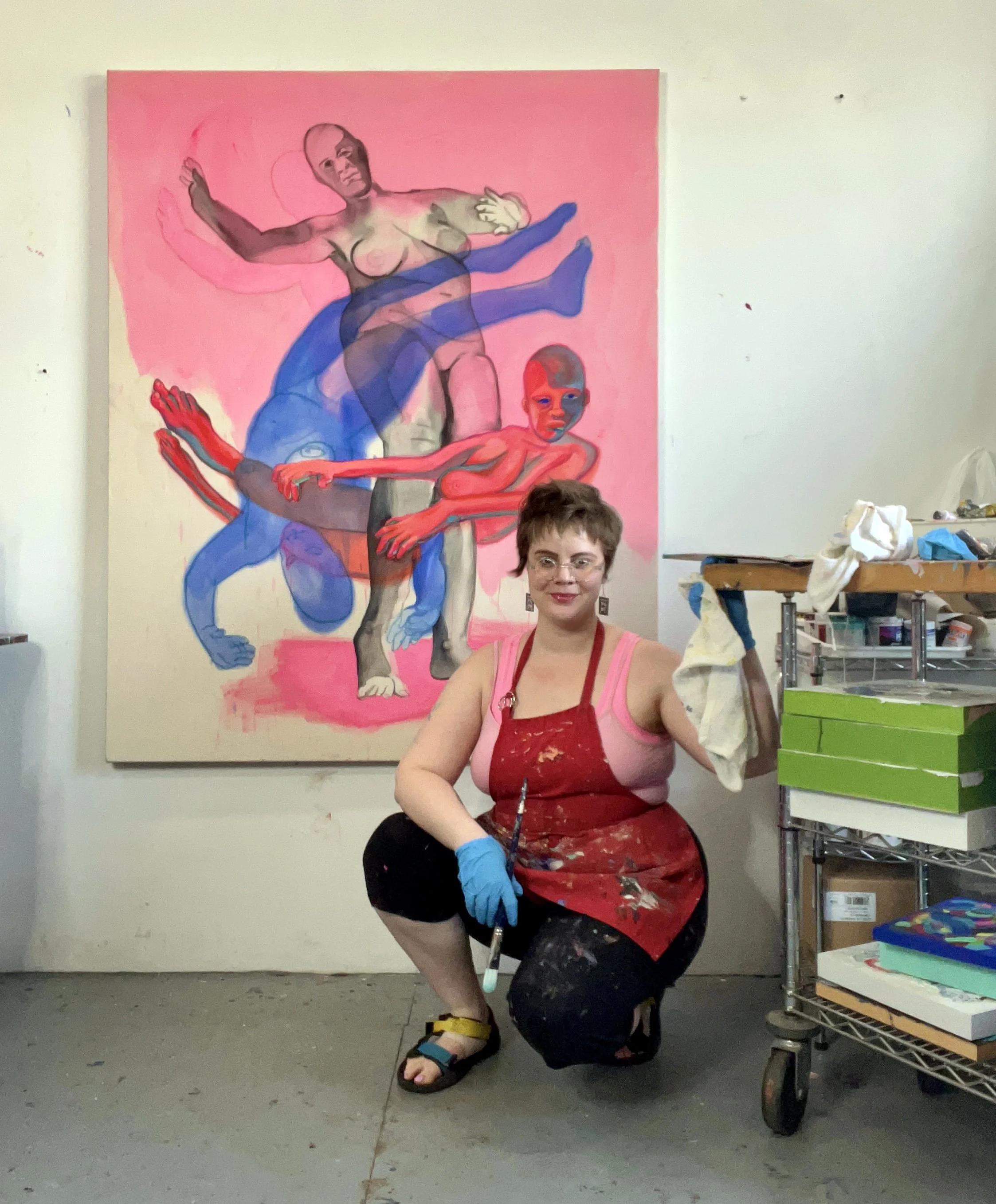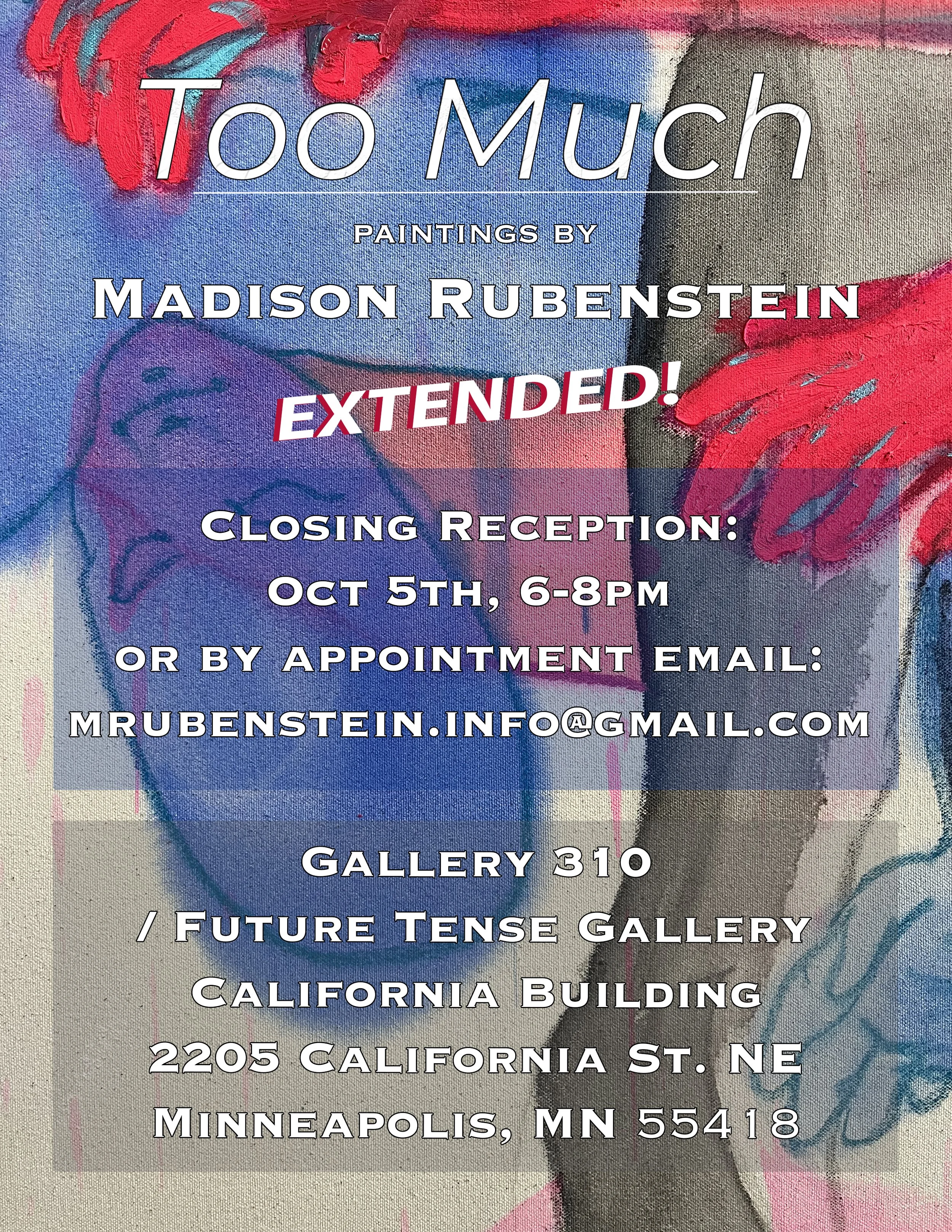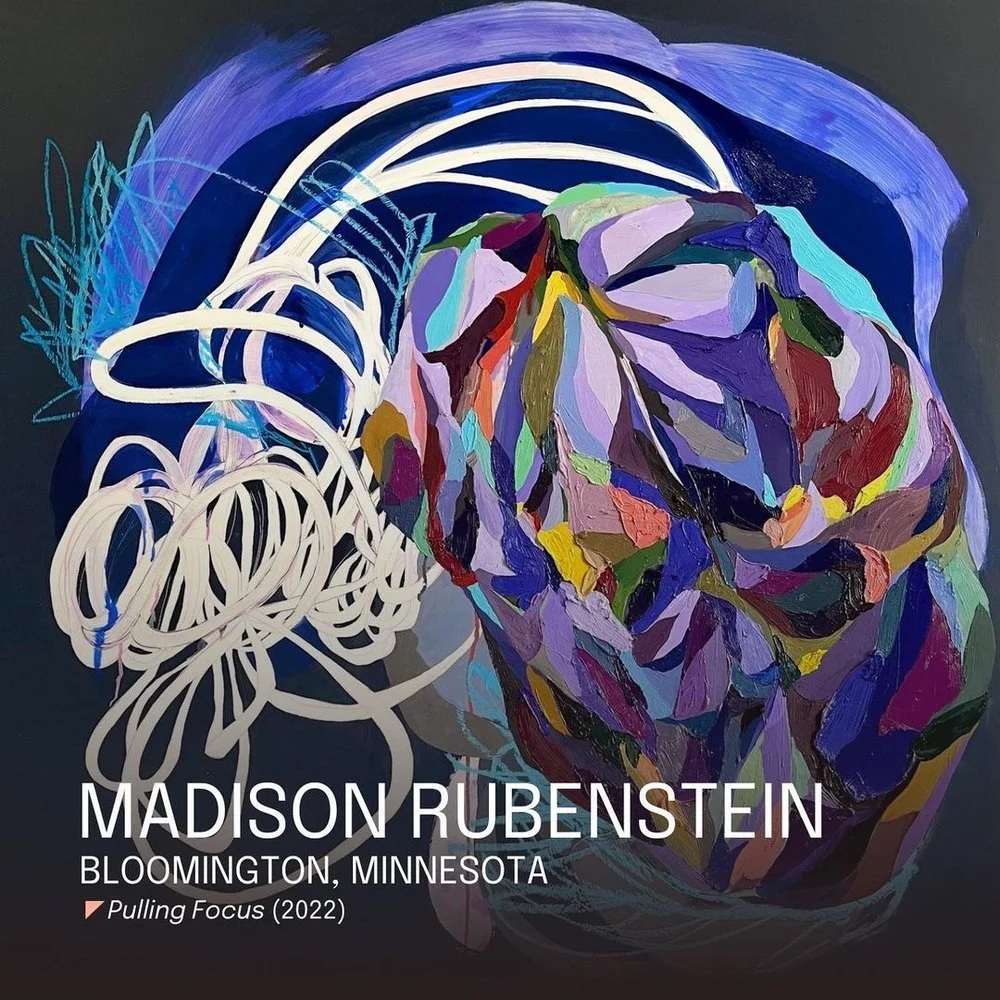Madison Rubenstein's interview with Minnesota Public Radio
Back in June I was given the incredible opportunity to sit down with MPR's Senior Arts Reporter & Critic Alex Cipolle for a conversation about my work as a feature for Disability Pride Month. Back in June I was given the incredible opportunity to sit down with MPR’s Senior Arts Reporter & Critic Alex Cipolle for a conversation about my work as a feature for Disability Pride Month. Check out the link below to read the full article and listen to the radio segment that aired last week!
READ THE ARTICLE HERE https://www.mprnews.org/story/2024/07/03/tangled-madison-rubenstein-paints-what-it-feels-like-to-live-with-invisible-illness
Harvard Innovation Labs and ArtLifting Announce Mural Installation by Madison Elyse Rubenstein
A reproduction of my painting “Invent, Endure, Outlive Them” is now a permanent mural at Harvard Innovation Labs. A huge thank you to ArtLifting for this partnership and lifting up the work of artists who live with disabilities or have experienced housing insecurity. You can read the blog about the mural written by Alex Parks for Harvard iLab here: https://innovationlabs.harvard.edu/about/news/artlifting-rubenstein-installation
A reproduction of my painting “Invent, Endure, Outlive Them” is now a permanent mural at Harvard Innovation Labs. A huge thank you to ArtLifting for this partnership and lifting up the work of artists who live with disabilities or have experienced housing insecurity. You can read the blog about the mural written by Alex Parks for Harvard iLab here: https://innovationlabs.harvard.edu/about/news/artlifting-rubenstein-installation
Special thank you to Hannah Temple and Tsibele for unearthing the song I mentioned in the article and for continuing the Jewish tradition of resistance.
By Alex Parks
2/13/2024
Today, the Harvard Innovation Labs has unveiled “Invent, Endure, Outlive Them,” the university innovation center’s first permanent mural installation. The mural was created by artist Madison Elyse Rubenstein and sourced through ArtLifting, a former Harvard Innovation Labs venture creating access to the art market for artists impacted by disabilities and housing insecurity.
When Liz Powers (Harvard College ’10) was a social worker running art groups in Boston shelters and social service centers, she discovered participants were producing extraordinary art but lacked a marketplace to showcase and sell their work. Powers founded ArtLifting out of her dorm room to connect talented underserved artists to professional opportunities.
“Liz joined the Harvard Innovation Labs soon after founding ArtLifting, and has been an incredible member of our community ever since,” said Alexandra Stephens, marketing and communications director at the Harvard Innovation Labs. “Our team has been inspired to see ArtLifting represent 190 artists across the country. We’re truly honored to have Madison Elyse Rubenstein’s work as a permanent installation at the Harvard Innovation Labs; the impact of their piece is stunning.”
Around the age of six, Rubenstein, who is gender-fluid and uses any pronouns, started developing chronic pain and extreme executive dysfunction. Drawing and painting became their tool to create visual representations of what they were experiencing. As a child, art also became Rubenstein’s therapeutic space to process their childhood emotions of feeling restricted by gender norms. They share:
“Since I was a child, I have painted how it feels to inhabit my body as a form of self-expression and reflection. I consider artmaking a necessary tool of adaptability, which helps me survive in the world as a disabled person.”
Rubenstein’s intricate, colorful art leaves the viewer captivated all while exploring important topics of the body, gender, and disability. In describing the meaning behind “Invent, Endure, Outlive Them”, Rubenstein shares the title is “inspired by an old Yiddish song born from anti-fascist Jewish resistance,” explaining:
“In 1939, a group of Hasidic Jews from the Polish city of Lublin were backed up against barbed wire and ordered to sing to their own execution. One of the men improvised: ‘Mir veln zey iberlebn, iberlebn, iberlebn’ — ‘We will outlive them.’ Instantly the song took hold of the Jews, until it activated them into a stormy and feverish dance. The commander at first laughed but then realized they weren’t following his orders; they were subverting his demands and defeating him. The Jews wouldn’t stop when ordered, even when the troops charged at them. Most of those Jews lost their lives that day but some lived to tell this story of resistance.
I often pull from my experience and history as a Jewish person to persevere in spite of living in a world that is not built to accommodate my disabilities. The title for me reads as a to-do list for survival: ‘Invent’ new worlds through art, ‘Endure’ my experience living in a broken society, and ‘Outlive’ those that would prefer I give up. There are many obstacles and limitations I face as a disabled person, but what I know to be unshakable is my passion for justice, my joy for art, and the perseverance of my lineage.”
This painting was created with a unique approach focusing on the interplay between colors and their surroundings. Rubenstein was intrigued by the way that colors can appear to vibrate, change, come forward, or recede in space depending on what other colors are in their vicinity. In addition to this exploration of color, Rubenstein also incorporated a variety of different brush strokes and mark-making techniques to create a sense of frenetic activity within the painting. Despite this energetic approach, the painting remains organized and cohesive, with each element working together to create a larger whole. Overall, Rubenstein’s approach to this artwork demonstrates a keen eye for detail and a willingness to experiment with different techniques to achieve a unique and engaging final piece.
“Invent, Endure, Outlive Them” was installed in the Harvard Innovation Labs in February 2024, and unveiled to the Harvard Innovation Labs community during spring orientation for the university innovation center’s more than 1,600 student members. Rubenstein comments on the intersection of art and innovation:
“I believe artmaking to be a vital tool in reinventing and conceiving a better world because it necessitates creative thinking and problem-solving. In the context of art, innovation, and disability, disabled folks are constantly dreaming and reinventing the world to create a reality in which we can survive. We have a greater capacity than our able-bodied peers to conceive of more radical and imaginative forms of community care.”
In reflecting on how they hope members of the Harvard Innovation Labs community will interact with the mural, Rubenstein says, “One of my favorite things about having my art viewed by people outside of my studio is the wide spectrum of interpretation, especially with abstract art. I hope that whatever my piece activates in an individual, that it inspires their own creative impulses through conversations, self-reflection, innovation, and maybe even a little artmaking of their own.”
Community members stop to take in "Invent, Endure, Outlive Them" during a tour of the i-lab.
“GHOSTS OF DESIRE AND SURVIVAL” MPLSART.COM WRITES ABOUT MY FIRST SOLO EXHIBITION “TOO MUCH”
My first solo-exhibition, entitled 'Too Much', opened on September 9th in the California Building! The show I put together is exactly what I envisioned at the start of 2023 and I feel so proud of what I brought to fruition. The newest paintings I created for the exhibition are the culmination of a long time goal: bringing together my abstract and figurative styles to create stronger narratives in my work. The week following my opening, MPLSART.COM released an article written by Benjamin Merrit about my newest paintings.
https://www.mplsart.com/written/2023/09/madison-rubenstein-too-much
My first solo-exhibition, entitled 'Too Much', opened on September 9th in the California Building! The show I put together is exactly what I envisioned at the start of 2023 and I feel so proud of what I brought to fruition. The newest paintings I created for the exhibition are the culmination of a long time goal: bringing together my abstract and figurative styles to create stronger narratives in my work. The week following my opening, MPLSART.COM released an article written by Benjamin Merrit about my newest paintings.
https://www.mplsart.com/written/2023/09/madison-rubenstein-too-much
Benjamin and I chatted in my studio the week leading up to the opening of my show. Three of my paintings were still in progress and despite feeling the edge of pushing myself a bit too hard (feeling that perfectionism) I knew that it was all going to come together and I just needed to pace myself.
I love talking to other artists about art. I love talking to other disabled people about being disabled. But even more, I love talking with disabled artists. Benjamin brought very thoughtfully crafted questions and jumping off points for our conversation and it felt easy to open up to him about what drives my work, because I know he gets it. The article he produced left me feeling so seen it moved me to tears.
The space in which my show was exhibited, Future Tense Gallery, is operated by artist Eyenga Bokamba. Eyenga generously offered for me to extend my show, therefore the closing reception was held on October 5th, 6-8pm!
More about the show:
The selection of paintings I curated depict chaotic emotional and psychological landscapes by referencing contorted, distorted, abstracted, and repeated renderings of my own body which reflect my personal experience with disability. Accompanying the paintings in the show is a zine of poetry I created using a typewriter, collage materials and my photocopier, which you can read in the gallery or take home with you. As Patreon subscribers you will also be receiving a copy of the poetry zine in the mail. The California Building houses artist studios and is not open to the public outside of designated open studio events, so please contact me if you would like to make an appointment for your own private viewing of 'Too Much'.
MADISON RUBENSTEIN IS 1 OF 9 ARTISTS TO RECEIVE THE 2023 MIDWEST AWARD FOR ARTISTS WITH DISABILITIES
Near the end of July (Disability Pride Month) I was notified that I am one of nine artists awarded with this year's Artists with Disabilities Grant by Arts Midwest!
This is the first year that Arts Midwest has offered this opportunity and I am so honored to be selected for this award and $3,000 in grant funds. Over 200 artists applied to receive funds and a panel of seven reviewers selected nine finalists from across the Midwest. I am grateful to have this financial support to further invest in my art career and small business.
Near the end of July (Disability Pride Month) 2023, I was notified that I am one of nine artists awarded with this year's Artists with Disabilities Grant by Arts Midwest! This is the first year that Arts Midwest has offered this opportunity and I am so honored to be selected for this award and $3,000 in grant funds. Over 200 artists applied to receive funds and a panel of seven reviewers selected nine finalists from across the Midwest. I am grateful to have this financial support to further invest in my art career and small business.
Arts Midwest is thrilled to announce the inaugural winners of the Midwest Award for Artists with Disabilities. This award, designed to support accessibility in the arts and celebrate the exceptional work of disabled Midwestern visual artists, has received an incredible response from the artistic community. Over 200 artists applied to receive funds, and a panel of seven reviewers narrowed the pool to nine finalists from across the Midwest.
We are delighted to recognize the creativity and dedication of nine incredible artists who have been making a significant impact in the field:
Matthew Bodett (Chicago, Illinois)
Larissa Danielle (Bloomington, Indiana)
Lauren Bonney (Decorah, Iowa)
Maggie Laycock (Sterling Heights, Michigan)
Madison Rubenstein (Bloomington, Minnesota)
Bonnie Lee (Fargo, North Dakota)
Andrea Sosa Fontaine (Cleveland Heights, Ohio)
Mary Payton Zajicek (Sioux Falls, South Dakota)
Sarah Muehlbauer (Milwaukee, Wisconsin)
As part of this award, each recipient will receive $3,000 to support their artistic journey, with no restrictions on how they choose to use this funding.
“We are honored to support these incredible artists through the Midwest Award for Artists with Disabilities,” says Torrie Allen, President and CEO of Arts Midwest. “We believe it’s one small step towards creating a more inclusive and accessible arts community where visual artists with disabilities can thrive.”
Established in 2022, the Midwest Award for Artists with Disabilities is supported by the James Edward Scherbarth and Paul Francis Mosley Giving Fund. The award was created in honor of the late James Edward Scherbarth, an award-winning visual artist, visual arts teacher, and advocate of arts access who lived and worked in Minnesota. Jim believed that creativity lives in everyone, and he dedicated his career to helping people express themselves through the visual arts.
ILLUSTRATION BY MADISON RUBENSTEIN FOR HIGH COUNTRY NEWS
In the wake of the Club Q mass shooting, reflections on an adolescence in the ‘Evangelical Vatican.’ Written by Brandon Sward.
In the wake of the Club Q mass shooting, reflections on an adolescence in the ‘Evangelical Vatican.’ Written by Brandon Sward.
https://www.hcn.org/issues/55-1/essays-growing-up-queer-in-colorado-springs/
After I came out as gay at age 15, my family’s home was vandalized. No note was left, but the safe-sex poster taped to the front door made it clear that I was the target. My parents said that I was putting my younger sisters at risk with my “lifestyle choices.” Years later, my mom told me how many friends she’d lost because of my coming out, as though expecting an apology or thanks.
In 2004, the country looked much different. Marriage equality was yet to come, and the military’s “don’t ask, don’t tell” policy was still in effect. Gay representation in popular culture ranged from the coiffed whiteness of Will and Grace to the satyric whiteness of Queer as Folk. Some things have not changed; LGBTQ people everywhere still face ostracism and violence. And Club Q was the only LGBTQ club I knew of in my hometown of Colorado Springs, a city of almost half a million.
At 15, I was very sad and very alone. I understood the concept of gayness, but I didn’t know any gay people. My coming out was a reaching out, a bid for understanding, although one therapist told my parents that I was just “going through a phase.” My parents, who didn’t have any gay friends, treated me like a stranger; I spent an entire summer under virtual house arrest.
I felt as if I’d done something horribly wrong, and in a sense I had. From my house, I could see both the campus of the U.S. Air Force Academy and the headquarters of Focus on the Family, one of the most virulently anti-LGBTQ organizations in the United States. Colorado Springs, which has been called the “Evangelical Vatican,” is home to no fewer than five military bases and 81 religious organizations.
The influence of these twin forces on my town, and on my adolescence, was unmistakable. After 9/11, the advent of the War on Terror kicked patriotism into overdrive, triggering a concurrent war on difference that was magnified by the intense military presence in the city. Same-sex couples were banned from my prom. The school’s theater department faced opposition to its production of The Crucible because of the play’s examination of witchcraft. Students argued with librarians about the categorization of religious texts; some LDS students, for example, wanted the Book of Mormon separated from the other “false” Christianities. My almost completely white choir once performed an African American spiritual about picking cotton.
I hung out with the bad kids, the only ones who seemed aware of the absurdity of it all, the ones who circled the mall like a watering hole. They smoked on the hill before class, had sex in public restrooms, and couldn’t have cared less about my nascent sexuality. I grasped for any means of control: I wore all black and stopped eating, until, at 5 foot 9, I weighed just 111 pounds. I slept less and less and began to spend my nights wandering my neighborhood’s streets. Eventually, I ended up in a psychiatric institution, where my fellow patients included a girl in withdrawal from crystal meth and a small boy who said a red fox had told him to kill his mother.
I only went to Club Q once. That was in the summer of 2007. I was 18 years old, just out of high school, working at Old Navy to earn some money before leaving for college. That evening, I met up with one of my managers, who was bisexual. I turned into the Club Q parking lot, which is shielded from the street by a wall of trees. I wasn’t sure I was in the right place, but then I saw the club’s multicolored sign glowing softly in the nighttime haze.
It was my first time at a gay club — probably my first time at any club — and the novelty of each experience crashed gracelessly into the next. After the bouncer checked my ID, I entered a shadowy hallway that opened into a single large room dimly illuminated by reddish lights. T-Pain’s “Bartender” blared over the speakers: I like the bartender … I’m at the bar with her. … The clientele was mostly young, male, thin. I found my manager and her friends, and we danced in a loose semicircle, shuffling slowly from right foot to left. I tried to focus but was distracted by the proximity of the bodies of strangers. Strangers, but not really strangers.
I’d been out for three years by then, but the only other queers I’d met were through school — a severely limited pool. That night at Club Q, a world opened to me. I didn’t talk to any of the gently swaying dancers, but the air between us crackled with electricity. The shift from long-held fantasy to flesh-and-blood potential was almost too much to bear, its erotic jolt as powerful and unexpected as the flash of a Victorian woman’s bare ankles. In the semi-darkness, the differences between us melted away, holding out the possibility that, together, we could be whole.
Note: This story was updated to correct that Club Q was the only LGBTQ club in Colorado Springs. It was the only gay club the author knew about.
Brandon Sward is an artist, writer and doctoral candidate at the University of Chicago.
MADISON RUBENSTEIN IS THINKING OUTSIDE THE BOX
If you are driving down France Ave in Edina, MN you might noticed some colorful artwork on an electrical box outside of Chase Bank at 7000 France Ave S.
If you are driving down France Ave in Edina, MN you might notice some colorful artwork on an electrical box outside of Chase Bank at 7000 France Ave S.
My painting “Invent, Endure, Outlive Them”, a title which references anti-fascist Jewish resistance is now prominently featured on an electrical box outside of the Edina branch of Chase Bank- an area that was historically regarded as dangerously anti-semetic. Racial covenants in the 1900’a barred Jews and Black folks from purchasing homes in the area- just a town over from where I grew up.
The art-covered electrical box is the result of a partnership with ArtLifting- a company that connects artists with disabilities with corporate clients. You can checkout my ArtLifting portfolio for available images on ArtLifting’s website here:
https://www.artlifting.com/collections/madison-elyse-rubenstein



